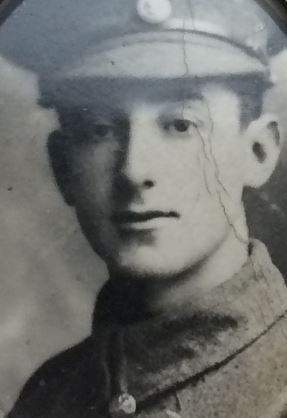Pte
Arthur James Hawley
Informations sur naissance
|
Année de naissance: 1897 |
|
Lieu de naissance: Cheadle, Staffordshire, Angleterre, Royaume-Uni |
Informations générales
|
Profession: Vendeur de magasin de textile |
Informations service militaire
|
Pays: Angleterre, Royaume-Uni |
|
Force armée: British Expeditionary Force |
|
Rang: Private |
|
Numéro de service: 241283 |
|
Incorporation nom de lieu: Cheadle, Staffordshire, Angleterre, Royaume-Uni |
|
Unités: — Northumberland Fusiliers, 1/5th Bn. (Dernière unité connue) |
Informations sur décès
|
Date de décès: 26/10/1917 |
|
Lieu de décès: Schaapsbalie, Langemarck, Belgique |
|
Cause du décès: Killed in action (K.I.A.) |
|
Âge: 20 |
Mémorial
|
Tyne Cot Memorial Panneau: 21A |
Distinctions et médailles 2
|
British War Medal Médaille — 27/04/1920 |
|
Victory Medal Médaille — 27/04/1920 |
Points d'intérêt 3
| #1 | Lieu de naissance | ||
| #2 | Lieu d'enrôlement | ||
| #3 | Lieu du décès (approximatif) |
Mon histoire
Arthur James Hawley was born in January 1897. He was the youngest child of Elizabeth and William Hawley of Cheadle, Staffordshire. According to the 1911 Census, Arthur worked as a Draper's Assistant. He enlisted in Cheadle and by the Battle of Passchendaele he was serving with the Northumberland Fusiliers, 1/5th Battalion, part of the 149th Brigade, of the 50th (Northumbrian) Division.
On 26 October 1917 the 50th (Northumbrian) Division attacked German positions in the Houthulst Forest, with the 149th Brigade. Its attack was carried by the 1/4th, the 1/5th, and the 1/7th Northumberland Fusiliers; the 1/6th Battalion was in support. The Northumberland Fusiliers advanced, behind a protective barrage. But it proved quite useless, as the artillery fired mostly shrapnel shells, which had no effect on the line of concrete blockhouses. The German machine-guns started enfilading the advancing troops. On top of the relentless machine-gun fire the men were hindered by the difficult terrain. Large areas of the battlefield had been inundated, due to the constant shelling.
Three minutes after Zero hour the German artillery put down a barrage and “A” Company was heavily shelled. Notwithstanding the hard going the Battalion succeeded in capturing their first objective.
“B” Company managed to reach Hill 23 but were soon fired upon by German machine-guns in Houthulst Forrest. When they reached the road running West of Schaapbalie, they were held up by barbed wire. The first and second waves attempted to cut the wire, but they were enfiladed by German machine-guns, firing from the Forest. The two waves were practically wiped out and the following waves were unable to advance. Meanwhile “C” Company’s advance had also been checked by machine-gun fire from a line of concrete huts. “D” Company had reached its first objective, but when they tried to renew their advance they came under heavy fire, slowing down the attack. Any further advance had become impossible.
All Companies suffered severe casualties and no one was able to reface the unforgiving machine-gun fire. The men were forced to retreat to their original line. Casualties were extremely high. Sixty-one men were killed outright, 156 men were wounded and 234 men went missing. Twenty year old Arthur James Hawley was one of the men who fell during the attack West of the hamlet of Schaapbalie. The young man has no known grave and Arthur is remembered on panel 21A of the Tyne Cot Memorial.
On 26 October 1917 the 50th (Northumbrian) Division attacked German positions in the Houthulst Forest, with the 149th Brigade. Its attack was carried by the 1/4th, the 1/5th, and the 1/7th Northumberland Fusiliers; the 1/6th Battalion was in support. The Northumberland Fusiliers advanced, behind a protective barrage. But it proved quite useless, as the artillery fired mostly shrapnel shells, which had no effect on the line of concrete blockhouses. The German machine-guns started enfilading the advancing troops. On top of the relentless machine-gun fire the men were hindered by the difficult terrain. Large areas of the battlefield had been inundated, due to the constant shelling.
Three minutes after Zero hour the German artillery put down a barrage and “A” Company was heavily shelled. Notwithstanding the hard going the Battalion succeeded in capturing their first objective.
“B” Company managed to reach Hill 23 but were soon fired upon by German machine-guns in Houthulst Forrest. When they reached the road running West of Schaapbalie, they were held up by barbed wire. The first and second waves attempted to cut the wire, but they were enfiladed by German machine-guns, firing from the Forest. The two waves were practically wiped out and the following waves were unable to advance. Meanwhile “C” Company’s advance had also been checked by machine-gun fire from a line of concrete huts. “D” Company had reached its first objective, but when they tried to renew their advance they came under heavy fire, slowing down the attack. Any further advance had become impossible.
All Companies suffered severe casualties and no one was able to reface the unforgiving machine-gun fire. The men were forced to retreat to their original line. Casualties were extremely high. Sixty-one men were killed outright, 156 men were wounded and 234 men went missing. Twenty year old Arthur James Hawley was one of the men who fell during the attack West of the hamlet of Schaapbalie. The young man has no known grave and Arthur is remembered on panel 21A of the Tyne Cot Memorial.
Sources 5
|
"Passchendaele. The Day-by-Day Account", McCarthy C., London, Uniform, 2018, pg. 150-152. Sources utilisées |
|
Ancestry https://www.ancestry.com/ Autre référence |
|
CWGC https://www.cwgc.org/find-war-dead/casualty/838981/hawley,-arthur-james/ Sources utilisées |
|
The Long, Long Trail http://www.longlongtrail.co.uk/army/ Sources utilisées |
|
War Diary Northumberland Fusiliers, 1/5th Bn. http://www.nmarchive.com/ Autre référence |
